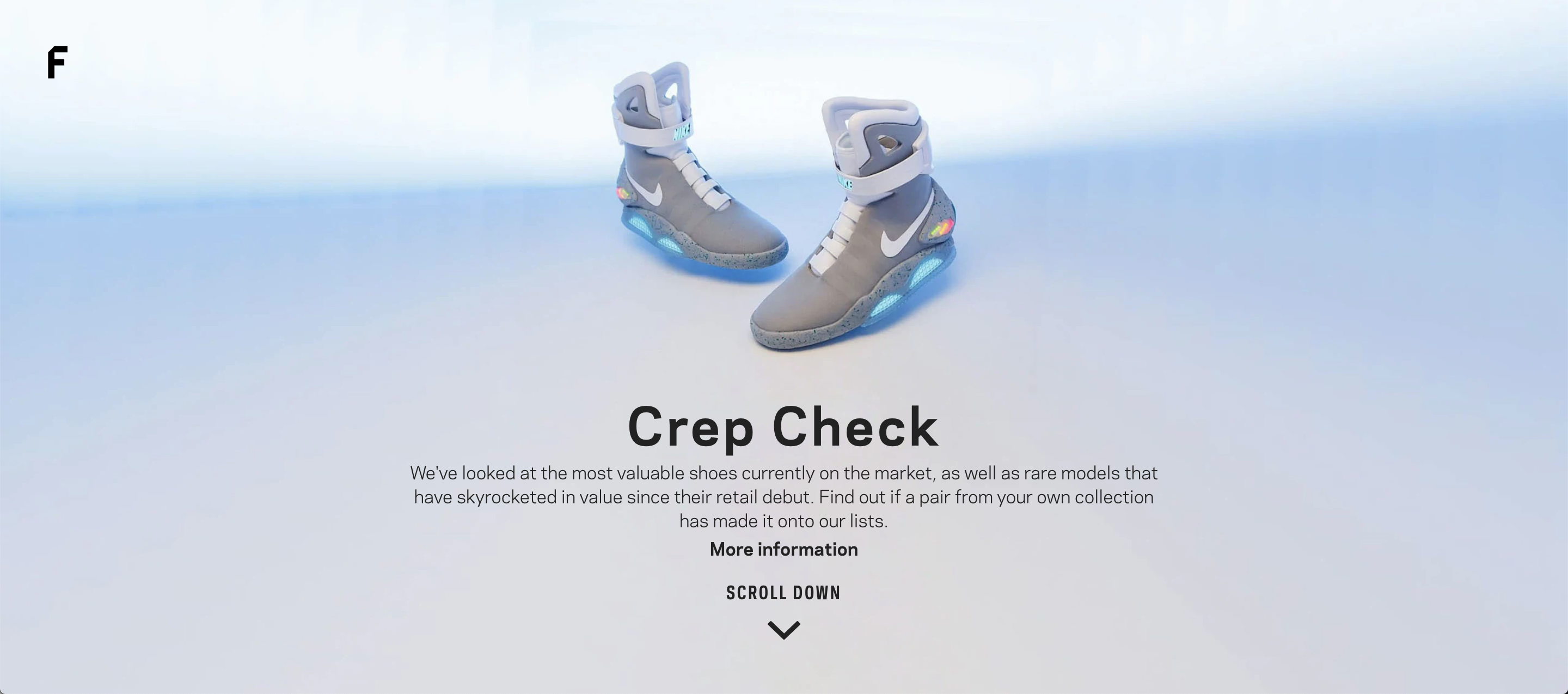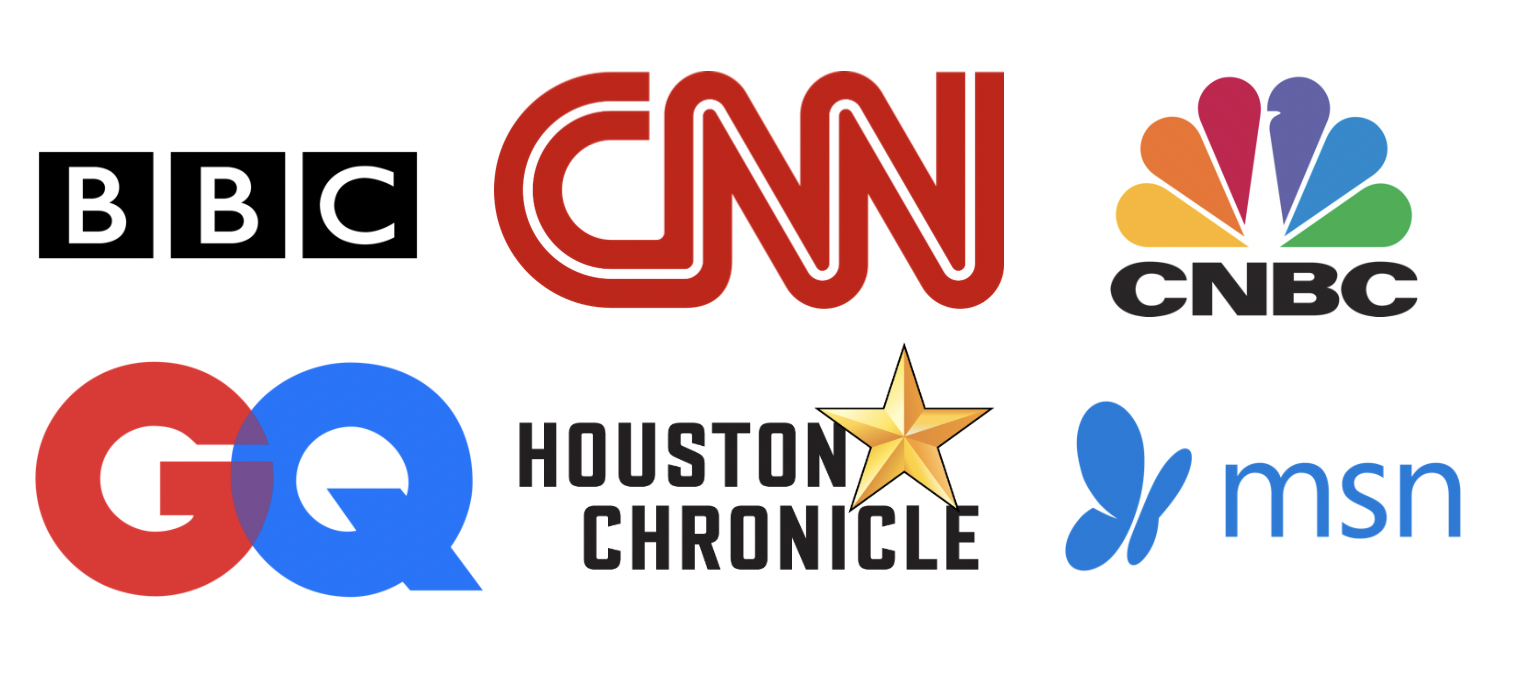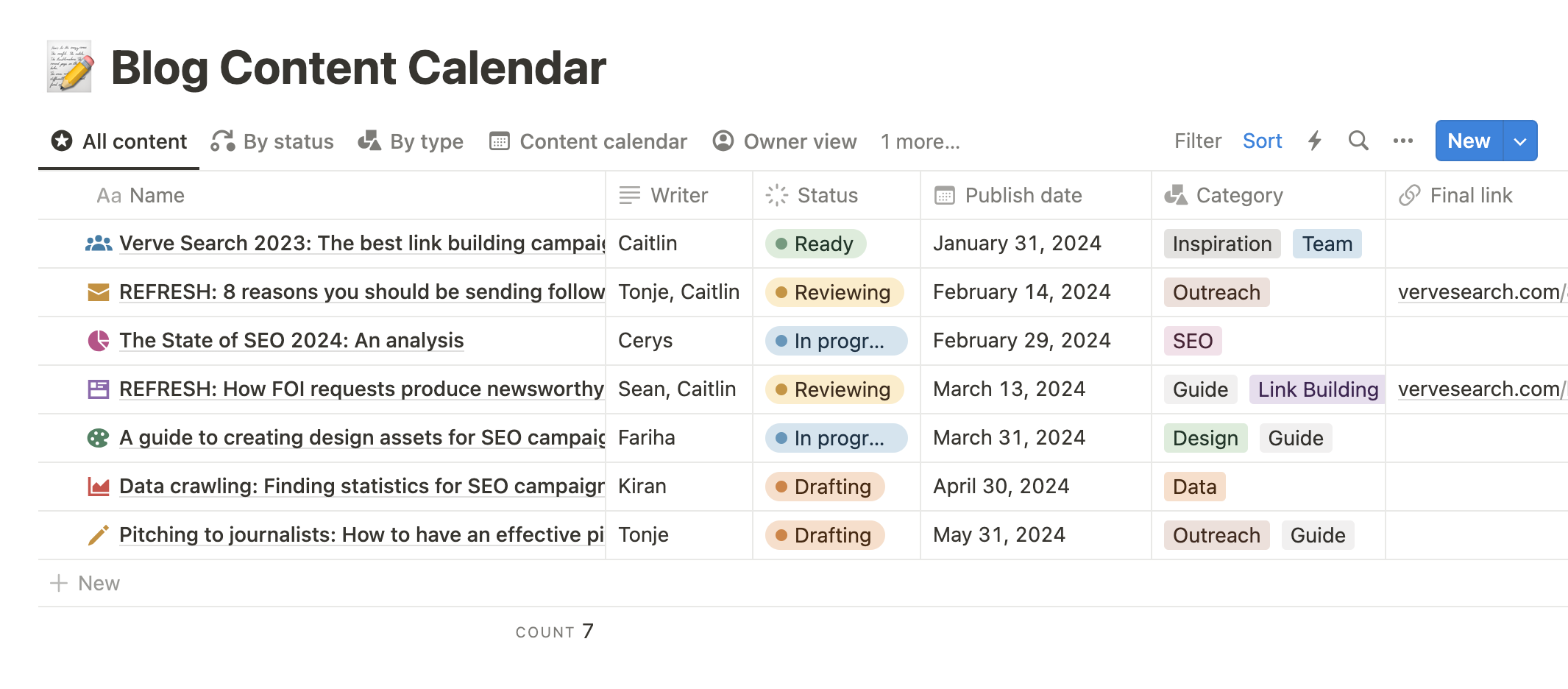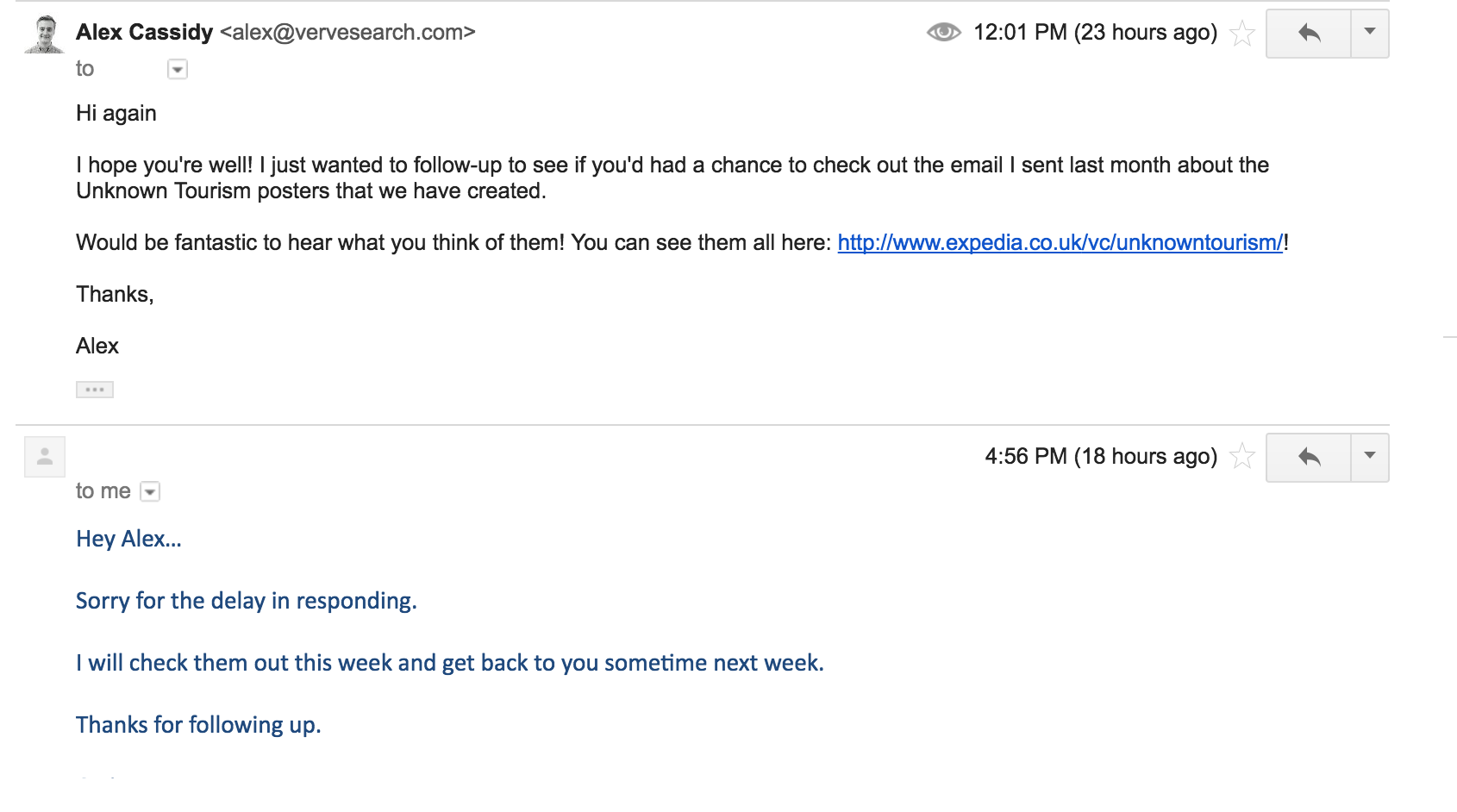Campaign Spotlight – Crep Check
Starting this month, we will be sharing with you an example of a campaign which has delivered amazing results for a client over the course of the previous month.
This month, we produced Crep Check for Farfetch, a luxury fashion retailer. The campaign looks at the most valuable trainers currently on the market, as well as those that have seen their value skyrocket since their initial release.

We teamed up with Stadium Goods to provide a definitive breakdown of the most valuable and appreciative trainers in modern times, and an explanation as to why so many of these shoes have become worth such vast sums of money.

Costing £22,763, The high-top ‘Jasper’ sneaker from the Kanye West x Louis Vuitton line are the most valuable on the market. Released in 2009, the shoes designed by West himself have increased by more than 2500%. They were initially available in three colourways but the pink and grey version is the most coveted.

We found that Nike’s What the Dunk trainers had the biggest value increase. Released in 2007 at £91, they were designed as a patchwork of previous patterns, colours and materials used in old Nike SB models. Today, they are worth £3,793, an increase of over 4000%.
We took inspiration for the campaign from high-profile trainer auctions and one-off celebrity releases, which have been sold for tens of thousands of pounds. The international news interest these stories generate inspired us to create a definitive list using data provided by one of Farfetch’s key brands.
We also liked the idea of showcasing trainers as alternative investments, a concept we previously explored with coins and toy cars. Lifestyle, fashion, and money journalists love to follow the most recent collectable trends and valuations in fashion.
Our designs took inspiration from ‘sneaker walls’, similar to those found in Stadium Goods’ stores in New York and Los Angeles. We also used price tags to show the rank number, making the campaign feel more like a high-end fashion index. We then researched each shoe using Stadium Goods’ index to provide some context to their value increase.

‘Crep Check’ launched on the 26th June, and to date, our outreach team have delivered 98 links totalling 3367 LinkScore (Verve’s own tool using a combination of metrics to measure the value of links). We were also able to build links in seven different countries.
Our outreach coincided with an auction of the world’s rarest trainers in New York set up by Sotheby’s and Stadium Goods. This included one of the first-ever shoes made by Nike in 1972, which sold for £350,000. The interest in this auction meant journalists were receptive to a report about the subject to inform their story.
It also coincided with a PR storm involving Nike removing a limited-edition shoe from retail following complaints about the use of the ‘Betsy Ross’ flag, which has since been associated with white supremacy after its use as the original US flag.
Both stories helped us to get linked coverage for the client in Business Insider, CNBC, GQ, Houston Chronicle, Yahoo Finance, AD (Netherlands’ second-largest newspaper) and CNN’s Style section. In addition, the BBC’s Newsround team wrote an article about the world’s most valuable trainers using the campaign data.

Blog for business: 9 tips on how to write an effective blog post
Adding a blog to your business website is a brilliant way to connect with your consumers and also adds strength to your brand.
Many businesses haven’t latched on to the idea that a blog is a beneficial tool to use. Most believe a blog can be time-consuming; that thinking up ideas for posts and honing the quality isn’t worth the effort. We, at Verve Search, believe that’s utter rubbish.

A business blog for your website is not a waste of your time or website space. In fact, it’s one of the most cost-effective ways to promote your business which will inevitably lead to more sales, establish yourself as a leading authority in the industry, and give you a chance to broaden your market reach. Plus, it’s bloody easy to blog. Everyone’s doing it these days. I bet even your own mother is a blogger. Believe me, that’s no insult.
Here are some top tips on how to blog for business professionals.
1. Write for your consumers – they are your readers, after all
Writing a blog for your business is completely different to a personal blog. In other words, it is not about you (sadly). Your business blog is about your business and your customers.
Always remember that the people who are going to read your blog are consumers and potential consumers, so write for them. Your blog posts should aim to answer any possible questions they may have and deliver new insights into your industry.
2. Plan business for blog content in advance
Phrase one: “There simply isn’t the time!”
Phrase two: “I have no idea what to write about!”
How many of you have used these two phrases as an excuse for not having a blog? Be honest. Well, brighten up lads and ladies for there is a solution: plan your blog posts. Lucky for you, we’ve attached an example of our content calendar below.
Every content calendar changes depending on your business needs and plans. Make sure to include a plan of title, who’s writing the piece, a proposed publish date and the categories you want this piece to sit in. These are all super important before you even start the drafting process.
This will solve any excuses for lack of time and ideas when the weekly calendar rolls around to blog-post-day (which should be around once a week by the way, more on that later). The benefits of mood boarding and brainstorming can take your blog that one step further. With a bit of planning at the start of each month, you can have enough ideas to keep the blog running for weeks.

3. Never underestimate the power of a good keyword
Overlooking the power of an SEO keyword is a big no-no. It impacts how a blog post is found in the search engine. The first thing a potential reader looks at is the title so you need a title that draws readers in and indicates what the post is about, whilst also including your keyword to be picked up by search engines.
Not sure what a ‘keyword’ is? Well, an SEO keyword is added to content online to make it optimized for a search engine. This means trailing the keyword throughout the content so that engines can pick up on what that content is about and rank it higher.
For example, notice how actionable the title of this blog post is indicating that you, the reader, will learn how to write a successful business blog. If I opted for a questioning title I could have gone for ‘Should You Add A Blog To Your Business Website?’ (The answer is ‘yes’ by the way).
4. Create constructive content on your blog for business
Providing your readers with valuable content is key to a successful business blog. It’s a way of establishing your business website as a leading authority in your industry. Writing about what you know is the easiest way to write.
For example, let’s say your business sells concrete countertops (yes, of course there are businesses for that!) which can admittedly be a dry subject but it’s your concrete business and you’re an expert on the subject. Write posts on the subject of choosing the right diamond pads for your concrete countertop, how fluctuating weather conditions can affect concrete, and what concrete countertops look like around the world. You can even veer away a bit and write something about how concrete is used in art projects. It’s all relevant and interesting content… as relevant and interesting as concrete can be.
Also, if you give readers posts that are informative and answer any questions they may have had on the subject they will reward you by becoming loyal consumers. Make your consumers see that you are the concrete solution to their concrete problem.
5. Blog little but often
Blog posts are not essays, so keep them short and sweet. People online are more likely to scan website content so it’s important to make every single word count.
If it takes you 1000 words or more to get a message across to your readers (just like this post) that’s absolutely fine. In terms of how often, the best practice is to blog at a consistency you believe you can maintain – once a week is good. Set a day to upload the post and stick to it. Search engines like new content and the more frequently you update your blog and website the higher your rankings.
6. Get the whole team involved
The blog shouldn’t be seen as one person’s sole responsibility. It’ll quickly become too overwhelming for that person and you’ll soon hear the two whining phrases outlined in point No.2. Give everyone a chance to write and share the responsibility of the blog. And when I say everyone I mean everyone from the CEO to the tea boy.
The best way to make this work is to draw up a blog rota every month. The different styles of writing and the voice that will emerge from your business will add more personality and ‘human’ depth. Plus, the more people you get to become bloggers, the bigger your pool of content ideas. Bonus.

7. Be inspired by your consumers
Remember that the consumers are your readers. Sometimes consumers have specific questions. Don’t just ask them in an FAQ section. Instead, answer the question by writing a post.
For example, your business sells concrete countertops (yes, seriously there are businesses out there that do that!) and consumers you’ve dealt with in the past wanted to know the ways to make their concrete countertops look more interesting. You can write a post outlining the options available to them from imbedding coloured glass to making a mosaic pattern, creating a marble effect or using glow-in-the-dark aggregate. Question answered.
Research what consumers are looking for by using the search engine. Look at search suggestions and related searches. Find keywords for your research. You can use a tool such as Google AdWords Keyword Tool to find keyword phrases that could turn into blog post titles which will drive more traffic to the blog.
8. Be visual
A simple technique to turn potential readers into actual readers is to provide images. Photos, graphs, infographics and videos have the power to communicate in a different, more instant, way than words. Images draw an audience in and provide an additional point of interest to your posts.
N.B. Do also make sure any images you use for your blog are either yours or Creative Commons images.
9. Analyse your blog for business performance
Use a web stats tool such as Google Analytics to measure your website’s performance. It’s free and is quick to install. You can use it to monitor how your blog’s performance is doing and get an idea of the ways people are finding your blog and what posts are the most popular. From all that information you can judge what’s been a success and how you can improve your future blog posts.
Interested in content marketing and digital PR services? Get in touch with us.
outREACH Conference

One dreary morning in January we decided that it would be a good idea to host a conference in the summer, you know, just to challenge ourselves a little. The next day the venue was booked.
A week later we’d got the branding sorted and had put up a page on the website. Now there are just a few days to go until outREACH, our first ever conference!
We are so humbled by the positive response we’ve had from brands, other agencies and freelancers, and we would like to thank everyone who has bought a ticket to support us. We cannot wait to meet you all on Friday!
We’d also like to say a massive thank you to our sponsors – DeepCrawl, ScribbleLive/Linkdex, Majestic & SEOMonitor, for their support.
As seasoned speakers, Lisa and Hannah knew exactly what was missing from the conference scene – a single track event 100% dedicated to outreaching content. Our event follows the whole process, with sessions on coming up with creative campaigns, how to get your ideas signed off, mindset, how to (and how not to) approach journalists, processes, tools, tips, and so much more. There is no other event like it in the SEO conference calendar.
We’ve hand-picked our speakers and the entire event has been planned around their specialist knowledge. You can see a full list of speakers on our agenda page here.

Jim will show you how to tame your tigers
Closing the conference is our keynote speaker, Mr Jim Lawless, with his tales on how he used the right mindset to ‘tame his tigers’ and become a jockey…oh, and also get in the record books.
outREACH takes place this Friday, 9th June, at the Congress Centre, 28 Great Russell Street, London WC1B 3EN.
If you would like to purchase a ticket (we have less than 15 remaining), click here and enter the promo code LASTCHANCE and you will be able to secure your ticket with a 30% discount off the ticket price.
We would really love to see you there!
How to Outreach Journalists in the Age of “Churnalism”
‘Churnalism is a form of journalism in which press releases, stories provided by news agencies, and other forms of pre-packaged material, instead of reported news, are used to create articles in newspapers and other news media.’
 Churnalism is a reality for many editorial teams in 2017. They no longer have the luxury of spending hours writing lyrical longform tomes on a subject of their choosing. Instead they are expected to produce 5-10 pieces of highly shareable content a day that will keep readers, and advertisers, coming back to the site.
Churnalism is a reality for many editorial teams in 2017. They no longer have the luxury of spending hours writing lyrical longform tomes on a subject of their choosing. Instead they are expected to produce 5-10 pieces of highly shareable content a day that will keep readers, and advertisers, coming back to the site.
As a result journalists need to not only know what’s happening now, they also need to know what’s coming next. The pressure is on them to deliver something that stands out in the hyper-competitive wormhole of the content marketplace.
So how do we effectively deliver content to such a pressured, busy group of people? What are the myths that need dispelling and what methods can we detail to ensure that we are doing everything within our power to ensure coverage from these websites?
- Give Them Everything
There’s a time and a place for suspense, but your outreach email isn’t it. You’re not Raymond Chandler, so include everything that a journalist needs to write an article in the first email.
The highest praise, and in many ways the ultimate goal, is to make it so that the journalist can practically copy and paste what you’ve said into their CMS, hit publish and move on to their next post.
The media landscape is geared towards one key factor: speed. If you can’t get there first, at least get there early. The early bird may get the worm but the second mouse gets the cheese.
By adapting your outreach to this mind-set and not making your email a riddle, you’ve already done 90% of the journalist’s job for them, increasing your chances of gaining coverage.
- Follow Up Follow Up Follow Up!
Not wanting to sound too dramatic, but outreach can sometimes feel like you’re shouting into the void. Despite multiple subject lines, constant tinkering and casting a wide net – replies don’t always come as thick and fast as you’d like.
But don’t let the silence stall your motivation. As Roman philosopher Seneca said ‘luck is when preparation meets opportunity’. The opportunities for coverage don’t end after the first email. Put simply: follow-ups are fundamental, so make sure to keep communication up at your end.
 I can count over a dozen recent instances where a journalist has enthusiastically covered a campaign without ever sending me back a reply. So firstly make sure to check to see if it’s been covered before you follow-up. As a start: search for the campaign (or set up alerts), check Majestic and monitor Google analytics. You may well find out about the coverage by reading about it online.
I can count over a dozen recent instances where a journalist has enthusiastically covered a campaign without ever sending me back a reply. So firstly make sure to check to see if it’s been covered before you follow-up. As a start: search for the campaign (or set up alerts), check Majestic and monitor Google analytics. You may well find out about the coverage by reading about it online.
But when do you stop? I tend to keep it to two maximum, after all, they may well not be replying because the campaign isn’t good enough, it’s not their beat, or what you’ve written hasn’t sold it to them. But it’s important to let them make that decision themselves, and by stopping at the first hurdle, you’re making it for them.
- Multiple People Same Publication
Don’t be afraid to email the same piece of content to multiple journalists at the same publication.
Yes, it’s important to keep emails personalised, but as we have already established, journalists are very busy people, and they understand that you need to cast a wide net to get the coverage. They’re not going to take it personally, simply because they don’t have the time.
It’s not worth only sending an email to an editor in the hope they will delegate it to a writer, or just sending it to a writer in the hope they will pitch it to their editor. It’s not a two birds one stone scenario – you want to hit as many birds with as many stones and, repeatedly, when necessary.
 Ultimately it’s worth remembering that in 2017 you are not only competing with the swathes of other link-builders, outreach people and PR professionals, but also with the journalist’s time. If you respect that, and adapt to their reality instead of trying to force your own, you will have a lot more success, and potentially make some reliable contacts for the future.
Ultimately it’s worth remembering that in 2017 you are not only competing with the swathes of other link-builders, outreach people and PR professionals, but also with the journalist’s time. If you respect that, and adapt to their reality instead of trying to force your own, you will have a lot more success, and potentially make some reliable contacts for the future.
Want to know more? We are hosting our very own conference 100% dedicated to outreach! Click the outREACH Conference logo for more information.
What Makes News?
“How do I get a journalist to cover my topic?”
This is a question that PRs constantly ask.
Experience teaches a lot about what news media’s preferences are, but learning what the definition of news is can be rather helpful as well:
The definition of news is simple. News can be defined as information about current events. 
Not all information about current events is news though.
A piece of current information becomes news when it is new, unusual, interesting, significant and about people. This can be an event, action or occurrence.
Let’s look at a few examples to understand better what actually constitutes news:
‘A bus driver drove kids to school this morning’ is not news. This piece of current information is about people, but it’s nothing new, nor is it unusual, interesting or significant.
If the bus driver hadn’t turned up to work in the morning and the kids were left at the bus stop waiting for their lift to school, it would be news , this event is at least unusual, maybe even interesting on a local level.
The aforementioned example also proves the importance of newness. The fact that the bus driver did not turn up to work and the kids were left to make their own way to school is news on the day it happened, and possibly in print 24-hours later.
News has to be something new. Unusualness or significance doesn’t help if the piece of information is already known to the general public.
To make headlines outside of a local newsbeat, the bus driver story would need greater significance.
The significance could be increased, for example, by very poor weather conditions , if the kids had to wait in an ice storm, the event would have been more widely significant and, therefore, a lot more newsworthy.
The involvement of people is key in this example as well. If the driver didn’t turn up to work but there were no kids at the bus stop waiting, the bus driver’s absence would not make news.
Sometimes a story does not require people to be the subject , like a hurricane for example , but the hurricane only becomes news if it touches people, or something connected to people, such as a house or bridge. In an uninhabited area, a hurricane is not news, but as soon as it threatens a town or a city populated with people, it becomes newsworthy.
So how do we apply this in our work?
Last autumn we created Polar Night Counter for Expedia Finland. It is a tool that counts down the days to the polar night , a period of time when the sun doesn’t rise above the horizon , and tells the length of the day in different parts of Finland.

The annual light phenomenon inside the polar circles has hardly anything to do with people , and one can’t call it very unusual either since it happens every year. How did we then manage to get any coverage for it?
The polar night isn’t about people but it definitely has an impact on people.
Just imagine being in Utsjoki, the northernmost town of Finland where in winter the sun doesn’t rise in 52 days. The dark period unarguably affects people , some say it makes them tired or even depressed, whereas others cherish the beauty of the mysterious blue light it creates.

MTV.fi is the online news site of Finnish MTV, one of country’s biggest commercial TV channels.
We turned the piece into news by listing the duration of polar night in northern cities and towns in Finland. We thought this would allow the newspapers’ readers to see clearly what the polar night means to them , in other words we made it clear how this phenomenon has an impact on people.
By picking the most interesting and newsworthy pieces of information and presenting it in an easily readable format we made it easy for media to cover the topic. The timing was also key: we contacted media early before the start of the polar night , because the start of the polar night is only news when it happens, not a day or two after. Polar Night Counter wasn’t only covered by local publications, but national too on the eve of the start of polar night in Utsjoki.

Ilta-Sanomat is one of the biggest online newspapers in Finland
So much about news! Hope this example helped you to understand the concept of news better.
Sources and further reading: The News Manual
Love is All Around
“I feel it in my fingers, I feel it in my toes, Love is all around me, and so the feelings grows!â€
These two lines of the cheesy 90’s pop tune perfectly describe the feeling at Verve Search HQ last week. It was the return of LOVE WEEK, a chance for the whole office to express how they feel about one another through the medium of being SECRET ANGELS!
 Every employee in the company (including the CEO) has their name put into a bowl and one at a time names are drawn. The name you draw is the person you will be a secret angel to for the week. The key to a successful love week is keeping your guise as secret angel – a secret.
Every employee in the company (including the CEO) has their name put into a bowl and one at a time names are drawn. The name you draw is the person you will be a secret angel to for the week. The key to a successful love week is keeping your guise as secret angel – a secret.
 You don’t have to spend lots of money on fancy-schmancy gifts, anonymous emails and little love notes are often the best love week gifts. This love week was even bigger and better than before, with object of affection ranging from flowers to beer to LP’s and Unicorn Poop!
You don’t have to spend lots of money on fancy-schmancy gifts, anonymous emails and little love notes are often the best love week gifts. This love week was even bigger and better than before, with object of affection ranging from flowers to beer to LP’s and Unicorn Poop!
Marcelle, our very lovely Project Co-Ordinator, gave this nice quote about love week: “Love week is great not just because you get presents or material gifts, but because people really go through such effort to learn more about you and what you LOVE! That looks different for everybody but it means that by the end of the week, you’ve got to know your co-worker a lot better”

A few years ago, Verve Search were inspired by the clever folks at Mindvalley to encourage love to be part of “everyone’s job description for five daysâ€. Verve been doing love week every quarter since, and it has become a fond tradition here at Verve Search. ♥
How We Got Guardians of the Galaxy Director, James Gunn, To Comment on Our Campaign
When James Gunn, Director of Guardians of the Galaxy, spent two hours on Twitter discussing one of our recent creative pieces, we knew it had gone viral. Following the success of Directors Cut, we’d like to share a bit about how we got there.

Made for our client, Gocompare.com, the piece racked up some nice numbers to go along with James Gunn’s comments on Twitter and Facebook:
- Over 48k shares in 48 hours
- More than 437 pieces of coverage, 90% linking directly to the piece (of which, less than 5% were no-followed) and about 40% directly linking to Gocompare.com’s life insurance product page
- Coverage on big name sites like The Independent, NME, IGN, Entertainment Weekly and The Guardian
- Viewing it through PR metrics – coverage on sites with a combined reach of nearly 400 million people, producing an AVE of £3.8 million.
All of the above happened within the first week of the campaign going live.
The Concept
Life insurance is a tricky subject to create content around due to the relatively serious nature of the product itself. We’re always looking to create content that covers multiple interest areas so that we can outreach in multiple verticals, so talking about fictional deaths in movies seemed to solve two problems at the same time.
We quickly came across a fan-made piece that had rounded up on-screen deaths and knew immediately that we were on to something:

Despite being a simple (maybe even ugly) graph, the above content managed to achieve some organic coverage on Business Insider, where it was viewed over 42k times. When this came out in early 2014 it clearly resonated with its audience despite the deadliest film being, unsurprisingly, Lord of the Rings: Return of the King, which is pretty much 3 hours of war.
We realised that by refreshing the data we would likely end up with a whole new list (there were some films since 2014 that we were just itching to add). By playing with the data we knew we could pull out new angles and by working on the design we could make it more accessible.
The Data
As much as we wanted to, binge watching movies wasn’t going to be an economical way to get the information. The original piece had pulled the information from a forum and so our original plan was to do the same. We updated the information and then ran until one of the biggest stumbling blocks of the piece – the data had hardly changed. At some point in late 2013, the forum had lost popularity and hardly any new films had been added since.
At that point we had a choice – either ditch the piece, go ahead with the information we had or find another solution. As professional maze walkers we naturally chose the latter. Through relatively extensive searching we found another option – a mixture of YouTube videos and forums that had newer counts, using the same methodology. By merging this data together, and adding in a serious chunk of validation, we now had a fresh perspective and interesting data we could use. Rising as the standout story from it was Guardians of the Galaxy in first position. Who would have thought that a film that features virtually no bloodshed – a Disney film – would be the deadliest? Not only do comic book/ Marvel movies practically have their own sub-genre (and separate list of fan sites) online, but Guardians of the Galaxy 2 is currently in production, making the campaign timely.
The Execution
At its heart the piece is a listicle; but if that’s all it became the best execution may have just been as a press release. What value could we add? We decided that, by adding information about each film in our top-ten, as well as imagery, we could do all the research for journalists, making the piece incredibly easy for journalists to write-up.
Meanwhile, we’d finished playing with the data, looking for secondary angles. We found interesting stories around years (“are films getting deadlier”), genre (“are horror films really the most deadly”) and ratings (“deadliest films aren’t necessarily R-rated”). We doubled-down on the execution to add a way to explore these secondary angles. These hooks were implicit so that we could take different angles to different journalists.
The outcome was:
- Simple – Guardians of the Galaxy Deadliest Film Ever
- Unexpected – it’s a family movie
- Concrete – We tell you exactly how many deaths and death, in itself, is a pretty concrete concept; and
- thanks to detailed supporting information we made available to journalists, Credible.
We knew that readers were likely to only read the headline, which meant that it was inevitable fiery debate would occur as to why the most deadly film wasn’t, instead, something like Star Wars where whole planets blew up. This emotional element would help to propel the campaign through social media, making it highly shareable.
Outreach
We don’t waste our time with bloggers and mid-tier publications. We believe that taking our campaigns to the largest sites in the world gives them access to huge audiences, which in turn leads to secondary pick up and huge results. This was no exception. What better place for a piece that talked about Guardians of the Galaxy than The Guardian? It’d give the piece a credibility boost, access to a huge audience and is a great link to have within itself. So, as the first site to be outreached to it was also the first coverage to go live:

Here’s a little secret – it also went live on NME and the Independent almost simultaneously. By making sure it appeared on multiple large sites at the same time we were hoping to begin an avalanche of coverage.
That’s when this happened:

James would spend over two hours on Twitter, sending over 50 tweets, talking about our campaign. It suited his agenda for the story to blow up as much as possible because he was busy feeding the publicity machine around the new movie. Meanwhile, the story was breaking elsewhere, gaining over 900 upvotes on Reddit and the social pressure from the coverage was creating a Twitter Moment:

Our outreach team quickly picked up James Gunn’s tweet and added it into their outreach emails – providing credibility to the piece and a further angle. In fact, James’ tweets were so noteworthy, many of the publications that had already covered the piece went back and covered it a second time. So far, within two weeks of launching, it has appeared on Yahoo a total of four times.
Soon, the piece had been covered on over 400 sites including:

Our Outreach team kept ahead of the coverage and, because we speak 12 different languages, we were able to take it to publications all around the world; starting new fires of publicity across the globe (including in France, Finland, Russia and Brazil).
Overall, we smashed all targets set for this piece by starting with a simple concept, producing new and surprising data, executing like a boss and staying nimble with outreach, getting coverage from some of the best sites in the world.











 Churnalism is a reality for many editorial teams in 2017. They no longer have the luxury of spending hours writing lyrical longform tomes on a subject of their choosing. Instead they are expected to produce 5-10 pieces of highly shareable content a day that will keep readers, and advertisers, coming back to the site.
Churnalism is a reality for many editorial teams in 2017. They no longer have the luxury of spending hours writing lyrical longform tomes on a subject of their choosing. Instead they are expected to produce 5-10 pieces of highly shareable content a day that will keep readers, and advertisers, coming back to the site. I can count over a dozen recent instances where a journalist has enthusiastically covered a campaign without ever sending me back a reply. So firstly make sure to check to see if it’s been covered before you follow-up. As a start: search for the campaign (or set up alerts), check Majestic and monitor Google analytics. You may well find out about the coverage by reading about it online.
I can count over a dozen recent instances where a journalist has enthusiastically covered a campaign without ever sending me back a reply. So firstly make sure to check to see if it’s been covered before you follow-up. As a start: search for the campaign (or set up alerts), check Majestic and monitor Google analytics. You may well find out about the coverage by reading about it online. Ultimately it’s worth remembering that in 2017 you are not only competing with the swathes of other link-builders, outreach people and PR professionals, but also with the journalist’s time. If you respect that, and adapt to their reality instead of trying to force your own, you will have a lot more success, and potentially make some reliable contacts for the future.
Ultimately it’s worth remembering that in 2017 you are not only competing with the swathes of other link-builders, outreach people and PR professionals, but also with the journalist’s time. If you respect that, and adapt to their reality instead of trying to force your own, you will have a lot more success, and potentially make some reliable contacts for the future.




 Every employee in the company (including the CEO) has their name put into a bowl and one at a time names are drawn. The name you draw is the person you will be a secret angel to for the week. The key to a successful love week is keeping your guise as secret angel – a secret.
Every employee in the company (including the CEO) has their name put into a bowl and one at a time names are drawn. The name you draw is the person you will be a secret angel to for the week. The key to a successful love week is keeping your guise as secret angel – a secret. You don’t have to spend lots of money on fancy-schmancy gifts, anonymous emails and little love notes are often the best love week gifts. This love week was even bigger and better than before, with object of affection ranging from flowers to beer to LP’s and Unicorn Poop!
You don’t have to spend lots of money on fancy-schmancy gifts, anonymous emails and little love notes are often the best love week gifts. This love week was even bigger and better than before, with object of affection ranging from flowers to beer to LP’s and Unicorn Poop!








